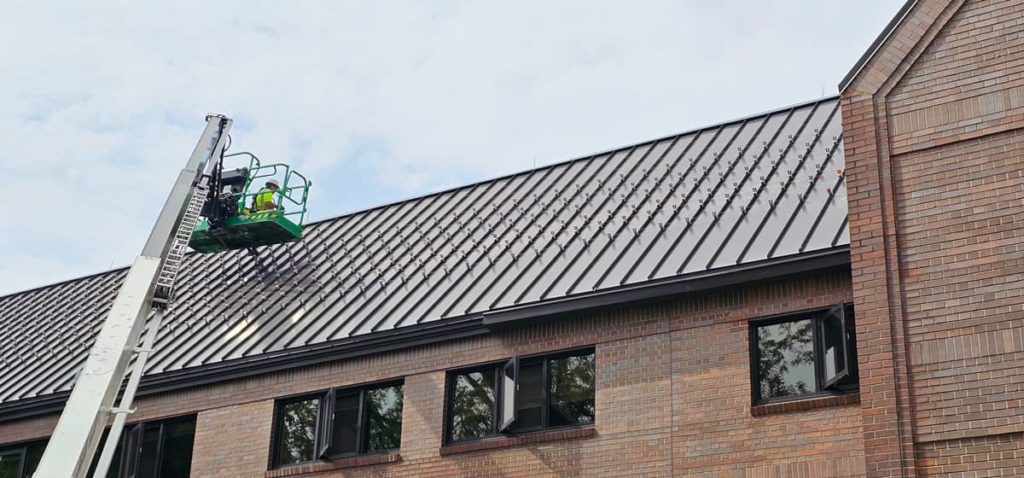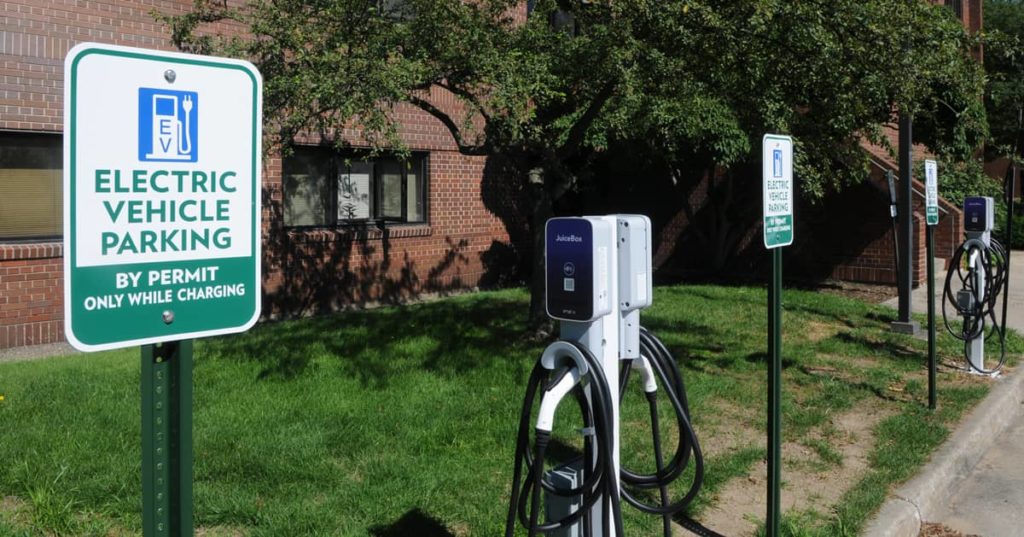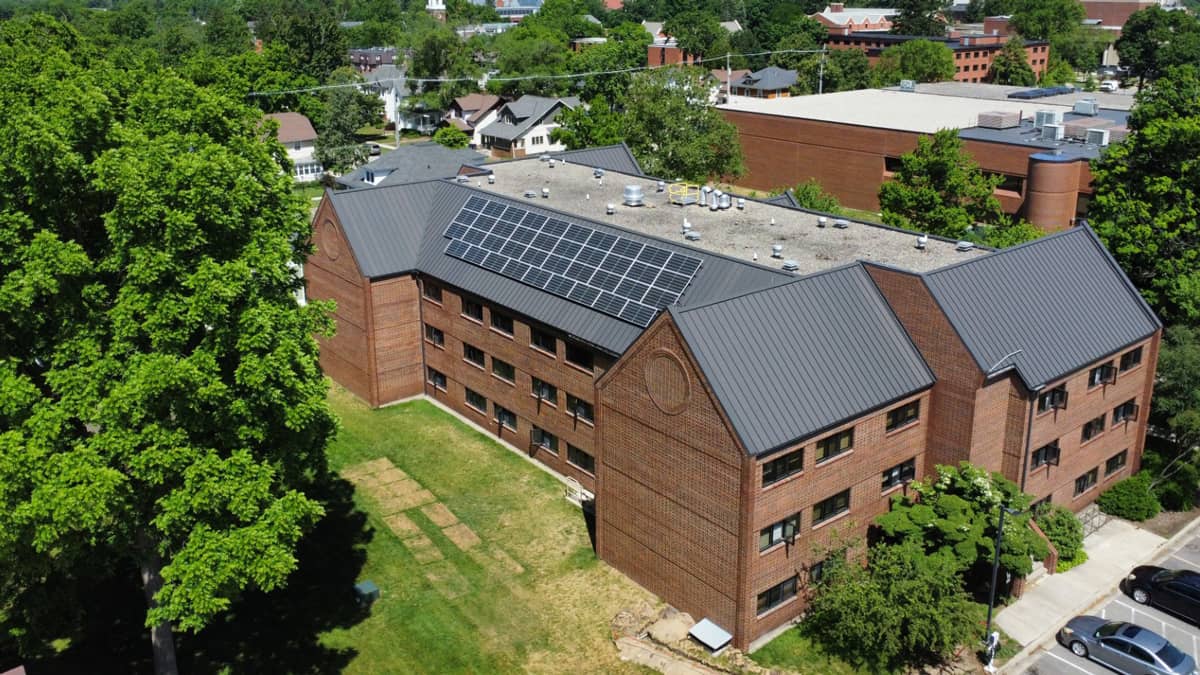The students in Hope’s introductory engineering course have helped shape the campus through an applied-learning class project that will have a lasting impact.
They developed a system for collecting solar energy to power four charging stations for students who have electric vehicles. It was installed this summer and went live earlier this month.
Although the stations and the panels that power them are located at Hope’s College East Apartments on 14th Street, students don’t have to be residents of the building to use them. Instead, any Hope student may purchase a special parking tag and have unlimited access to the chargers for the entire school year to power their electric vehicle.
Not least of all, the system will still yield benefits even when vehicles aren’t connected to the chargers.
“It’s tied to the grid, so it will all go right into the building,” said Michelle Seppala Gibbs, director for the Office of Sustainability. “If students aren’t charging their cars, the energy that the system is generating will be used elsewhere on campus.”
The chargers aren’t the first on campus. There’s also a charger in one of the college’s lots for faculty and staff. They are, though, the first to be solar-supplied.

The solar-energy collection system at College East joins two others on campus, which were also devised by students in engineering courses. A prior introductory class developed the system that recharges the battery-powered golf carts and other equipment that the groundskeeping and physical-plant staff use as they care for the 200-acre campus and its facilities. Students in the senior-level engineering-design course developed a solar-energy system for Kleinheksel Cottage, a college-owned house that was built as a family home in 1892, which has been retrofitted with a variety of enhancements as a model “green cottage.” Members of the college staff or contracted firms completed the installation. Hope worked with Harvest Solar on the purchase and installation of the project at College East.
The solar-energy collection system installed at College East this summer joins two others on campus, which were also devised by students in engineering courses.
Fittingly, given the nature of the assignment, it’s by carefully considered curricular design that Hope students have such experiences not only as seniors who are about to graduate but as newly-arrived freshmen in their first-ever engineering course.
“We’ve tried in our intro engineering course to provide an opportunity for students to get a little bit familiar with and kind of touch the engineering-design process,” said Dr. Jeff Christians, associate professor of engineering, who taught the fall 2022 course that led to this summer’s installation. “Usually what that looks like is some sort of semester-long project mixed with the course and the lab.”
“It’s a really valuable experience for students to see how some of the math and calculations that they do as homework problems help them with these bigger, more amorphous projects,” he said. “A big piece of engineering is balancing trade-offs and economics and multiple other factors that you’re trying to weigh, where there may not be a ‘right’ answer.”
“It’s a really valuable experience for students to see how some of the math and calculations that they do as homework problems help them with these bigger, more amorphous projects… A big piece of engineering is balancing trade-offs and economics and multiple other factors that you’re trying to weigh, where there may not be a ‘right’ answer.”
Dr. Jeff Christians, associate professor of engineering
The students worked in about 20 small groups spread across multiple course and lab sections, each team devising a concept and determining the potential benefit, technical specifications and projected cost. They then shared their proposals amongst one another, and all of the students chose their favorites based on considerations such as impact and practicality, with the top vote-getters receiving a closer look and additional refining en route to the final choice.
“I remember that one of the students commented when we were doing the evaluations, ‘We could put a lot of solar panels in this location — we just have to cut down that tree,’” Gibbs recalled. “Well, we put a lot of research into our trees, too — they also provide a lot of benefit. A few of the projects recommended putting the panels in one location and the chargers in another, but when they calculated the cost they realized that they could do a larger project for the same amount if they were nearer to one another. So, it’s trying to balance out some of those things with a more holistic approach.”
Accordingly, College East made the best choice. Although its location a couple blocks from the center of campus was one of the trade-offs, the three-floor building has a large, peaked roof with a south-facing side — ideal for a large number of panels to be installed with no trees blocking the sun — and an adjacent parking lot.
Nick Duthler ’09, who is Hope’s Physical Plant project manager, has appreciated not only the opportunity to work with the students, but seeing them experience the same sorts of situations that they’ll encounter as professionals.
“It’s been fun as staff to be involved in these projects with students,” he said. “Having worked in the construction side of projects and being in operations here at the college, it’s great to see students getting that practical knowledge. If you can do that while you’re here in school and not have to learn it by the school of hard knocks when you’re on projects and out in the world, you’re way ahead.”

The funds used to purchase and install the solar panels and chargers at College East haven’t come from the college’s operating budget but were donated specifically for student-focused sustainability efforts by Hope alumni Dr. Anne Deckard ’73 Hiskes and Dr. Richard Hiskes ’73, whose careers have included teaching and administrative roles at the University of Connecticut and Grand Valley State University, and who have long been interested in creation care and environmental justice. They have also provided support for the retrofitting of Kleinheksel Cottage, grants to faculty to expand sustainability into the curriculum and across the different academic divisions, and matching other gifts to the college’s Green Revolving Fund for sustainability projects, and initiated the creation of the “Hope Sustains” affinity group in 2022 to provide a way for alumni to connect with others committed to stewardship of creation and to make a difference at and via the college.
“Hope Sustains” is among multiple Hope organizations connected through the Office of Sustainability, with the college’s overall vision for sustainability guided by the “Green Team,” a committee of students, faculty and staff. The office’s website, hope.edu/sustainability, includes information about initiatives on campus to reduce waste, energy use and negative environmental impact, and resources for those interested in enhancing their sustainability practices.
Not incidentally, the college’s entire model for underwriting new sustainability initiatives is sustainable. By reducing the use of resources — say, for example, by underwriting the installation of energy-efficient lights in buildings — the initiatives also reduce the college’s operating expenses. Hope measures the impact and directs some of the monetary savings to the Green Revolving Fund to support new projects and continue the cycle.
Not incidentally, the college’s entire model for underwriting new sustainability initiatives is sustainable. Hope measures the impact and directs some of the monetary savings to the Green Revolving Fund to support new projects and continue the cycle.
“So, it’s not theoretical,” Duthler said of the difference made by the college’s sustainability efforts. “And [the fund] keeps regenerating every year.”
In the same way, Hope will collect data about the energy produced by the solar panels and monitor use of the new charging stations, since their availability is something of an experiment: How much demand will there be? Will there be any demand? What is the relationship between supply and demand?
“It’s a little like the chicken or the egg: Do you have a demand for EV charging and that’s why you put them in, or do you put them in and by increasing the infrastructure make electric vehicles a more viable option?” Duthler said.
“This is kind of a test case,” he said. “If we can prove that students are using them, we’d love to do more around campus.”
If you are interested in supporting sustainability initiatives at Hope, please contact the college’s Office of Sustainability at [email protected] or by calling 616.395.6811 to request additional information.



Where is Hope College? It must be a sunny part of the world!